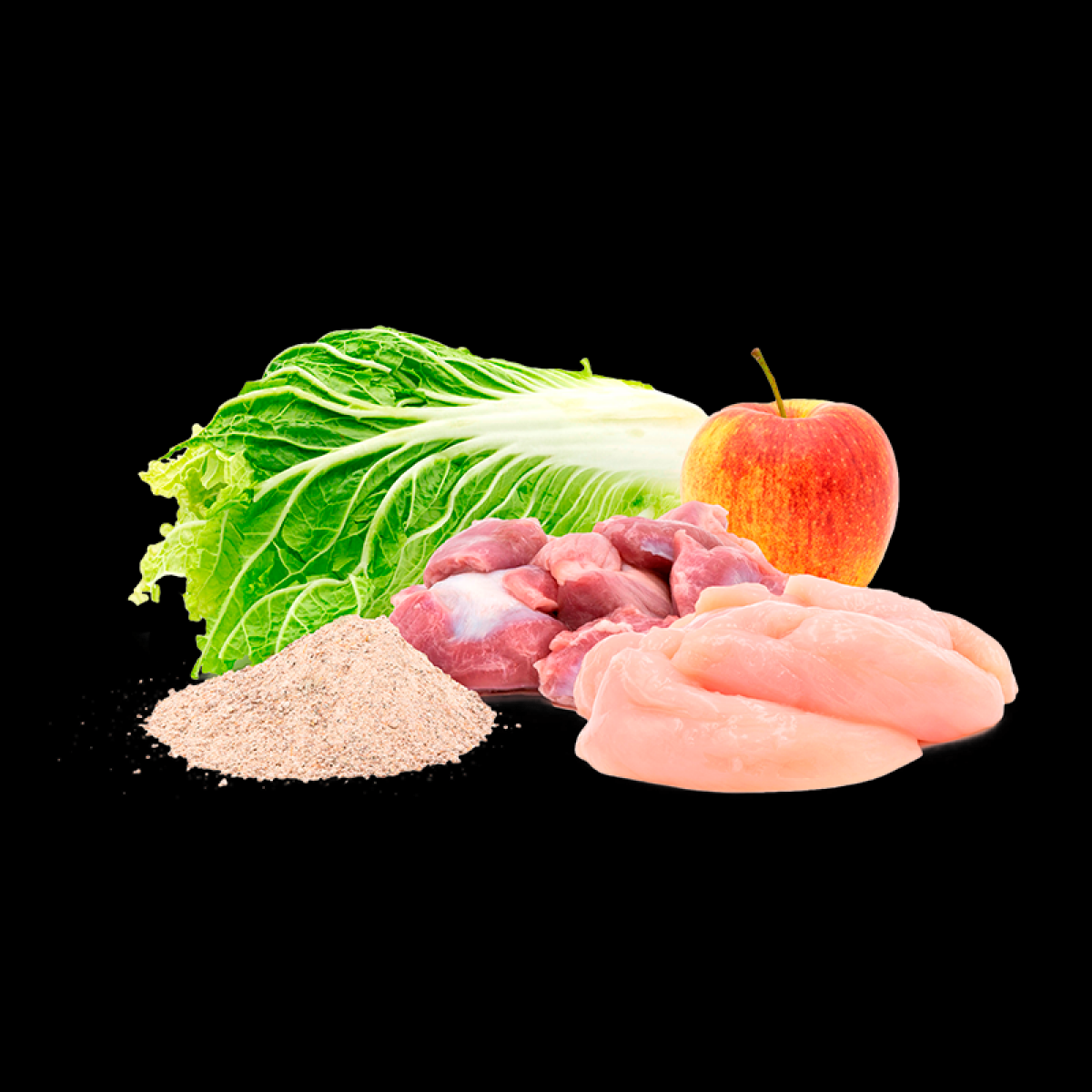
Raw feeding - BARF for dogs and cats - Part II: Single feeds
MedUP vetpool
Nadine Paßlack, Jürgen Zentek
BARF or raw feeding of dogs and cats is enjoying increasing popularity. This can be explained not least by the fact that many owners want their animals to be fed "naturally", based on the original diet of the dog or cat (BARF = "Bones And Raw Foods"). It is the task of the veterinarian to inform about possible risks and to give adequate hints for a sufficient energy and nutrient supply of the animal.
Part II of this article presents the individual feeds.
- Keywords
- barf
- nutrition
- raw feeding
- raw food
- digestion
- malnutrition
Single feeds
Straight feedingstuffs for dogs and cats may be of animal, vegetable or mineral origin. Although traditional animal feeds dominate, plant products are also of great importance today.
Meat
Meat primarily provides high-quality protein and, depending on the animal species source, also fat. Lean meat, for example, comes from poultry, rabbits and horses, while pork and sheep meat are richer in fat. Both the energy content (0.5-2 MJ ME/100 g) and the protein : energy ratio (6-38 g vRp/1 MJ ME) vary accordingly. The digestibility of the protein is very high with 98%, if the meat is very sinewy, the digestibility is somewhat lower. A meat feed alone is not sufficient to cover the requirements, as many minerals and vitamins are lacking: the contents of calcium, sodium, iodine, copper and manganese as well as vitamin A and vitamin D are low. After one-sided meat feeding, corresponding symptoms of failure can occur on the skeleton or thyroid gland. In addition, due to the high protein intake, faulty fermentation is possible in the large intestine (heeling of greasy, malodorous faeces).
Forestomacks and stomach
Rumen is available in uncleaned (green rumen) and cleaned form (white rumen). The protein quality is lower than that of meat (Table 2) and may cause digestive problems such as flatulence in dogs. The levels of calcium and fat-soluble vitamins are low, so that appropriate supplements are required. Pig stomachs are richer in fat than ruminant stomachs, but the mineral and vitamin contents are similar.
Liver, kidney
Liver and kidney are highly digestible organs that are usually eaten by dogs and cats. The organs are rich in protein (25 %) and relatively low in fat (~ 5 %), the calcium content is similarly low as in muscle meat.
The high amounts of iron, copper and vitamin A in the liver are important, as are the contents of vitamin B2, B12 and biotin. For this reason liver can be well used as a mineral and vitamin supplement in rations, especially if the pet owner rejects a commercial vitaminated mineral feed. It should be noted that cats should not be given an excessive amount of liver, otherwise there is a risk of developing serious bone disorders (cervical spondylosis with one-sided liver feeding!). Dogs seem to have a higher tolerance to vitamin A.
Sloughterhouse waste rich in connective tissue
Slaughterhouse waste rich in connective tissue includes lungs, udder, spleen, intestines, ears, tendons, rind, cartilage and other materials. Although they are protein-rich feeds, digestibility in the small intestine is low. Rather, the undigested protein is increasingly broken down in the large intestine by the bacteria living there, which increases the risk of dysbiosis and digestive disorders (see above). The amino acid composition of the sloughterhaus waste is unfavourable and the mineral and vitamin contents are even lower than in meat.
Blood, bacon, sausage
Blood is hardly ever fed these days. It provides high-quality protein, sodium and iron and is also rich in vitamins. Streaky bacon as well as back fat are above all energy suppliers, which generally show a high acceptance. Sausages have a high fat, medium protein and low mineral and vitamin content.
Milk and dairy products
Milk and dairy products such as cheese or quark provide high-quality protein as well as some quantitative elements and vitamins. The high lactose content (approx. 5 g/100 ml) is particularly limiting in the feeding of cow's milk. As the enzyme activity for breaking down milk sugar decreases with age, adult dogs and cats usually tolerate only small amounts of milk (max. 20-40 ml/kg body mass per day). The lactose content in quark, yoghurt or cream cheese is significantly lower than in cow's milk, so that these feeds can be used in larger quantities in the feeding of dogs and cats. Skimmed milk should be judged similarly to whole milk, only the lower energy content due to fat withdrawal and the loss of fat-soluble vitamins should be taken into account.
Eggs
Eggs supply predominantly protein and fat (egg yolk). They are highly acceptable and easy to digest when cooked. The ratio of protein to energy (g vRp : MJ ME = 14:1) is favourable and the egg yolk also contains high levels of essential fatty acids (positive effect on the sheen of the fur) and vitamins. Raw eggs cannot be fed in large quantities to dogs and cats for the following reasons:
- A trypsin inhibitor contained in the egg white impairs protein digestion and promotes digestive disorders.
- An antinutritive substance also found in egg white, avidin, binds biotin and leads to classic deficiency symptoms within a few days.
- Both substances are thermolabile and can be largely inactivated by cooking.
Fish and fish products
Fresh fish must always be cooked. On the one hand, raw fish poses a general risk of infection by parasite intermediates and bacteria. On the other hand, thiaminases (vitamin B1-cleaving enzymes) are another problem, as they can cause a vitamin B1 deficiency in dogs and cats.
These enzymes are inactivated when the fish is cooked. Furthermore, a substance called trimethylamine is found in raw fish, which can cause anaemia if fed one-sided with fish for a long time. This substance can also be inactivated by cooking. Finally, it should be pointed out that dogs in particular often smell like fish quickly after eating fish, which is a limiting factor not least for pet owners. For these reasons, fish and fish meal should only be used in limited quantities in dogs and cats.
bones
Bones are often used for raw feeding. They supply calcium and phosphorus in particular, but also magnesium, sodium and zinc. 1 g of bones per kg body mass per day is sufficient for the supply of calcium and phosphorus. Although these values are frequently exceeded in practice, the total daily intake of bone should not exceed 10 g/kg body mass, otherwise constipation (so-called bone faeces) may occur. Furthermore, the origin of the bones should be taken into account during feeding:
For example, less hard bones from younger animals (calf, fattening pig, poultry) or bones of a certain origin (ribs, sternum) are suitable as mineral supplements. Since bones from wild animals or older poultry splinter more easily, they should not be used in the feeding of dogs and cats.
Harder bones (upper arm or thigh bones) can also be used to keep the animals busy. However, there is a certain risk of tooth fractures. Positive effects on dental health may be achieved by feeding the bones of younger slaughtered animals. The chewing activity achieves a cleaning effect of the teeth and thus prevents plaque formation to a certain extent.
Cereals
Grain is a typical supplier of starch and therefore energy. It is low in protein and has only moderate protein quality due to its low content of essential amino acids. With the exception of oats and barley, cereals are low in crude fibre and their fat content is low, except for oats and maize. With regard to mineral content, it should be noted that cereals have an unfavourable calcium : phosphorus ratio because they are low in calcium and rich in phosphorus. Phosphorus is mainly bound to phytic acid. Since this compound must first be broken down by special enzymes (phytases), phosphorus from cereals is less well digested than from animal feeds. The trace element content in cereals is only moderate.
Noodles and potatoes
Noodles and potatoes are rich in starch and provide energy. For sufficient starch digestion, these feedstuffs must be cooked before feeding. Noodles and potatoes are poor in other nutrients, but potatoes have very high potassium contents. Due to their high solanine content, potatos that have turned green (buds) must not be fed to dogs and cats.
Vegetables and fruit
In dogs in particular, vegetables are often used in feeding in order to achieve a sufficient crude fibre content in the ration on the one hand and to provide minerals and vitamins on the other. It should be noted, however, that the mineral and vitamin requirements of dogs and cats cannot be covered when feeding normal amounts of vegetables (up to 5% of the total dry substance). An additional supplementation over a vitaminiertes mineral feed or other fodder is therefore necessary.
Onions in excess (> 5 g/kg body mass per day) are harmful, as is garlic. Some vegetables, such as tomatoes or carrots, have higher levels of pectins, which also makes them of dietary interest: The pectins are fermented by bacteria in the large intestine and can thus contribute to the stabilisation of the intestinal microbiota. Fruit is rich in water and fibres and provides water-soluble vitamins. Some have a mild laxative effect. In plums, the seeds must be removed before feeding, otherwise obstipations may occur.
Fats and oils
Fats and oils provide essential fatty acids and are typical sources of energy. In addition, they are important for the absorption of fat-soluble vitamins in the intestine and they increase the acceptance of a food. Depending on the origin of the oil, there are clear differences in the contents of n-3 and n-6 fatty acids (Table 4). Dietetically favourable are high levels of n-3 fatty acids, as these have an anti-inflammatory effect (Fig. 8).
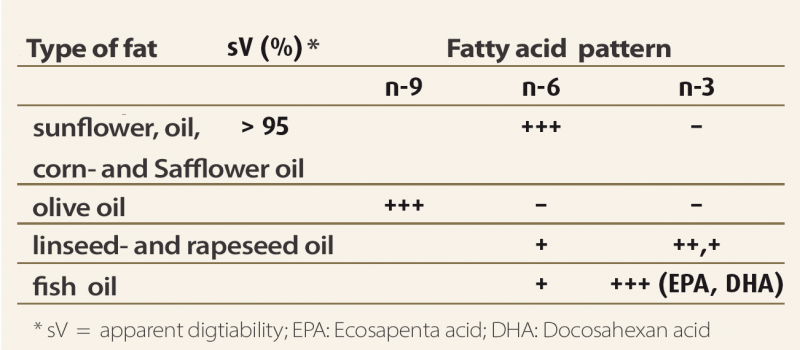
Tab. 4: Overview of the n-9, n-6 and n-3 fatty acid contents of different types of oil.
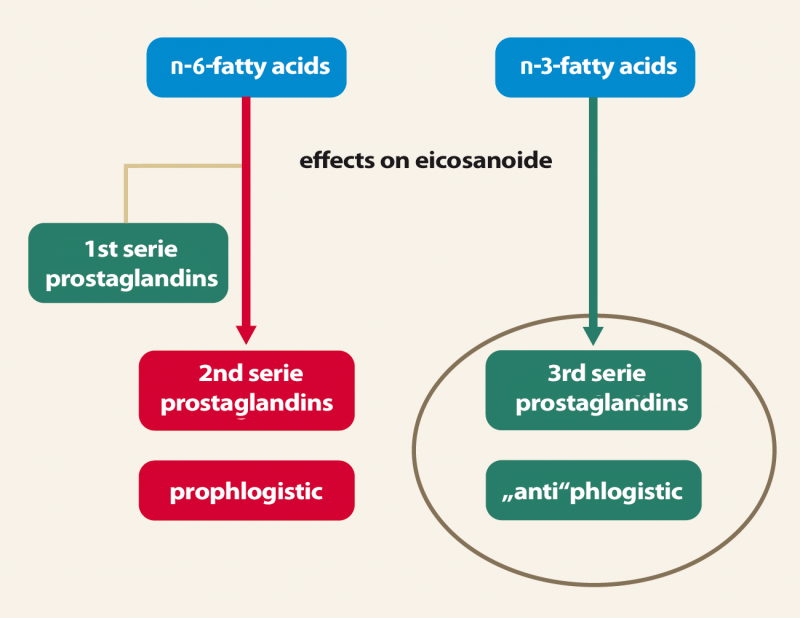
Fig. 8: Both n-3 and n-6 fatty acids are precursors of prostaglandins, which play an important role in inflammation: While n-3 fatty acids are degraded to series 3 prostaglandins, which have anti-inflammatory effects, the degradation of n-6 fatty acids results predominantly in series 2 prostaglandins, which have anti-inflammatory effects. Exceptions are borage oil and evening primrose oil, which contain larger amounts of dihomo-_-linolenic acid. This n-6 fatty acid is preferentially degraded to series 1 prostaglandins, which in turn have anti-inflammatory effects.
Ration design
The classical ration structure for dogs is shown in Fig. 9. In adult dogs and working dogs, half (or a little more) of the ration can be made up of carbohydrate suppliers. As already described above, this point can be problematic during raw feeding, as many carbohydrate sources have to be cooked before feeding (pasta, rice, potatoes). If animal owners generally refuse to cook, oat flakes may still be used as a source of carbohydrates, as they have already been heated during the production process, which ensures good starch digestibility. Under certain circumstances, animal owners who want their animals to be fed raw may also be generally averse to carbohydrate suppliers. In principle, this can be dispensed with completely in the composition of a ration for dogs and cats, but it should be noted that in these cases the protein content in the ration is very high. This may cause digestive problems such as flatulence or diarrhoea in the animals, as the enzyme capacity for protein digestion in the small intestine is overloaded and more undigested protein reaches the large intestine (see above, see Fig. 7, Part I). Overall, the proportion of meat should therefore be as balanced as possible in relation to the other ration components.
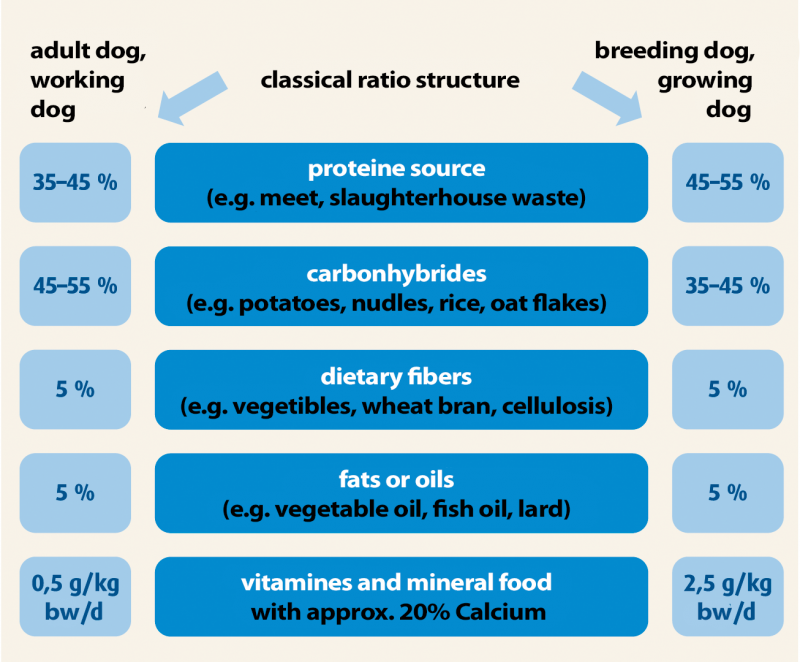
Fig. 9: Classical ration structure for dogs in different life phases or under different loads. g/kg KM/d: grams per kilo gram body mass per day
Supplementation with oils or fats to provide essential fatty acids as well as animal feed for the supply of minerals and vitamins is important for a sufficient ration. The latter can be supplemented with a vitaminized mineral feed. If the pet owners reject such products, the combination of liver and bone can also be used. Finally, dietary fibres (crude fibre) should complete the ration to ensure sufficient intestinal motility. Fruit, vegetables or even feed cellulose are possible. Tables 5-7 show exemplary rations for dogs and cats without the use of a carbohydrate source. It should always be borne in mind that the amounts of food used can vary greatly depending on the type of food (especially lean or fatty meat) (see Tables 5 and 6).
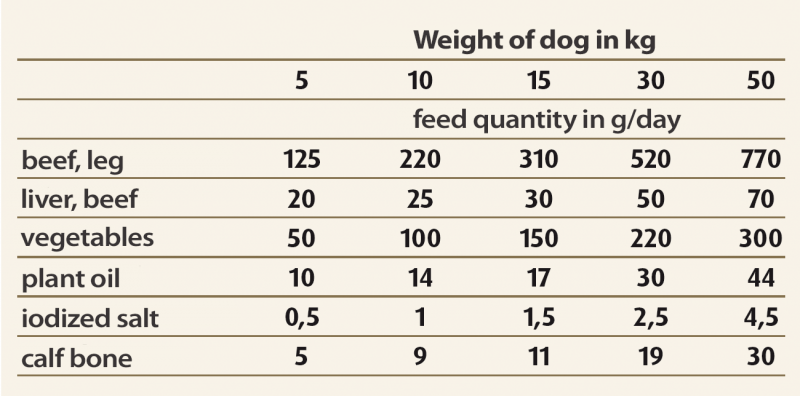
Table 5: BARF ration based on beef for dogs.

Table 6: BARF ration based on sheep meat for dogs.
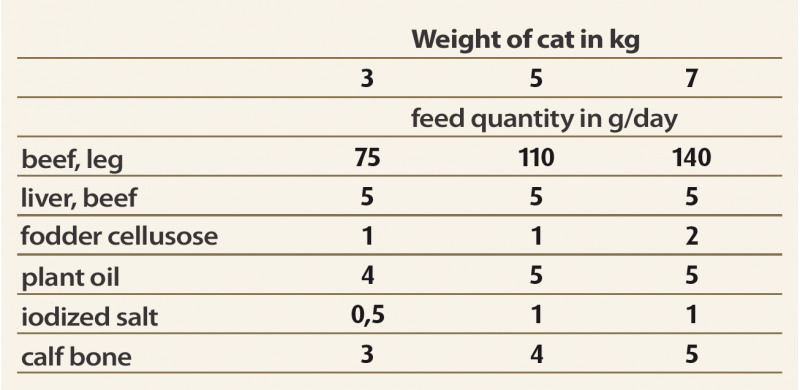
Table7: BARF beef-based ration for cats.